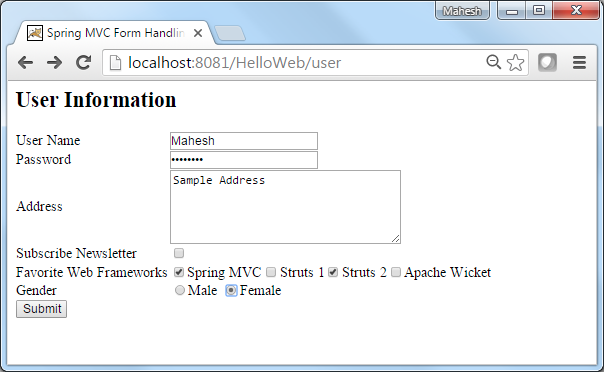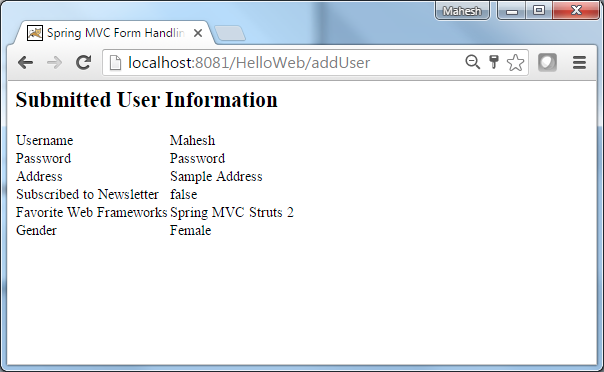Spring MVC-表单(Form)标签-单选按钮(RadioButton)示例(转载实践)
以下内容翻译自:https://www.tutorialspoint.com/springmvc/springmvc_radiobutton.htm
说明:示例基于Spring MVC 4.1.6。
以下示例说明如何在使用Spring Web MVC框架的表单中使用RadioButton。首先,让我们使用Eclipse IDE,并按照以下步骤使用Spring Web Framework开发基于动态窗体的Web应用程序:
| 步骤 | 描述 |
|---|---|
| 1 | 创建一个名为HelloWeb的项目,在一个包com.tutorialspoint下,如Spring MVC - Hello World Example章节所述。 |
| 2 | 在com.tutorialspoint包下创建一个Java类User,UserController。 |
| 3 | 在jsp子文件夹下创建一个视图文件user.jsp,users.jsp。 |
| 4 | 最后一步是创建所有源和配置文件的内容并导出应用程序,如下所述。 |
User.java
package com.tutorialspoint; public class User { private String username; private String password; private String address; private boolean receivePaper; private String [] favoriteFrameworks; private String gender; public String getUsername() { return username; } public void setUsername(String username) { this.username = username; } public String getPassword() { return password; } public void setPassword(String password) { this.password = password; } public String getAddress() { return address; } public void setAddress(String address) { this.address = address; } public boolean isReceivePaper() { return receivePaper; } public void setReceivePaper(boolean receivePaper) { this.receivePaper = receivePaper; } public String[] getFavoriteFrameworks() { return favoriteFrameworks; } public void setFavoriteFrameworks(String[] favoriteFrameworks) { this.favoriteFrameworks = favoriteFrameworks; } public String getGender() { return gender; } public void setGender(String gender) { this.gender = gender; } }
UserController.java
package com.tutorialspoint; import java.util.ArrayList; import java.util.List; import org.springframework.stereotype.Controller; import org.springframework.web.bind.annotation.ModelAttribute; import org.springframework.web.bind.annotation.RequestMapping; import org.springframework.web.bind.annotation.RequestMethod; import org.springframework.web.servlet.ModelAndView; import org.springframework.ui.ModelMap; @Controller public class UserController { @RequestMapping(value = "/user", method = RequestMethod.GET) public ModelAndView user() { User user = new User(); user.setFavoriteFrameworks((new String []{"Spring MVC","Struts 2"})); user.setGender("M"); ModelAndView modelAndView = new ModelAndView("user", "command", user); return modelAndView; } @RequestMapping(value = "/addUser", method = RequestMethod.POST) public String addUser(@ModelAttribute("SpringWeb")User user, ModelMap model) { model.addAttribute("username", user.getUsername()); model.addAttribute("password", user.getPassword()); model.addAttribute("address", user.getAddress()); model.addAttribute("receivePaper", user.isReceivePaper()); model.addAttribute("favoriteFrameworks", user.getFavoriteFrameworks()); model.addAttribute("gender", user.getGender()); return "users"; } @ModelAttribute("webFrameworkList") public List<String> getWebFrameworkList() { List<String> webFrameworkList = new ArrayList<String>(); webFrameworkList.add("Spring MVC"); webFrameworkList.add("Struts 1"); webFrameworkList.add("Struts 2"); webFrameworkList.add("Apache Wicket"); return webFrameworkList; } }
这里第一个服务方法user(),我们已经通过名为“command”的ModelAndView对象中传递了一个空的User对象,因为如果您在JSP中使用<form:form>标签,Spring框架将期望一个名为“command”的对象文件。所以当user()方法被调用时,它返回user.jsp视图。
将在HelloWeb/addUser URL上针对POST方法调用第二个服务方法addUser()。您将根据提交的信息准备您的模型对象。最后,将从服务方法返回“user”视图,这将导致渲染users.jsp
user.jsp
<%@taglib uri="http://www.springframework.org/tags/form" prefix="form"%> <html> <head> <title>Spring MVC Form Handling</title> </head> <body> <h2>User Information</h2> <form:form method="POST" action="/HelloWeb/addUser"> <table> <tr> <td><form:label path="username">User Name</form:label></td> <td><form:input path="username" /></td> </tr> <tr> <td><form:label path="password">Age</form:label></td> <td><form:password path="password" /></td> </tr> <tr> <td><form:label path="address">Address</form:label></td> <td><form:textarea path="address" rows="5" cols="30" /></td> </tr> <tr> <td><form:label path="receivePaper">Subscribe Newsletter</form:label></td> <td><form:checkbox path="receivePaper" /></td> </tr> <tr> <td><form:label path="favoriteFrameworks">Favorite Web Frameworks</form:label></td> <td><form:checkboxes items="${webFrameworkList}" path="favoriteFrameworks" /></td> </tr> <tr> <td><form:label path="gender">Gender</form:label></td> <td> <form:radiobutton path="gender" value="M" label="Male" /> <form:radiobutton path="gender" value="F" label="Female" /> </td> </tr> <tr> <td colspan="2"> <input type="submit" value="Submit"/> </td> </tr> </table> </form:form> </body> </html>
这里我们使用<form:radiobutton />标签来渲染HTML单选按钮。例如
<form:radiobutton path="gender" value="M" label="Male" /> <form:radiobutton path="gender" value="F" label="Female" />
它将呈现以下HTML内容。
<input id="gender1" name="gender" type="radio" value="M" checked="checked"/><label for="gender1">Male</label> <input id="gender2" name="gender" type="radio" value="F"/><label for="gender2">Female</label>
users.jsp
<%@taglib uri="http://www.springframework.org/tags/form" prefix="form"%> <html> <head> <title>Spring MVC Form Handling</title> </head> <body> <h2>Submitted User Information</h2> <table> <tr> <td>Username</td> <td>${username}</td> </tr> <tr> <td>Password</td> <td>${password}</td> </tr> <tr> <td>Address</td> <td>${address}</td> </tr> <tr> <td>Subscribed to Newsletter</td> <td>${receivePaper}</td> </tr> <tr> <td>Favorite Web Frameworks</td> <td> <% String[] favoriteFrameworks = (String[])request.getAttribute("favoriteFrameworks"); for(String framework: favoriteFrameworks) { out.println(framework); } %></td> </tr> <tr> <td>Gender</td> <td>${(gender=="M"? "Male" : "Female")}</td> </tr> </table> </body> </html>
完成创建源和配置文件后,导出应用程序。右键单击应用程序并使用Export->WAR File选项,并将您的HelloWeb.war文件保存在Tomcat的webapps文件夹中。
现在启动您的Tomcat服务器,并确保您可以使用标准浏览器从webapps文件夹访问其他网页。现在尝试URL http://localhost:8080/HelloWeb/user,如果您的Spring Web应用程序的一切都很好,您应该会看到以下结果:

提交所需信息后,点击提交按钮提交表单。如果您的Spring Web应用程序的一切都很好,您应该会看到以下结果:

Maven示例:
https://github.com/easonjim/5_java_example/tree/master/springmvc/tutorialspoint/test9


